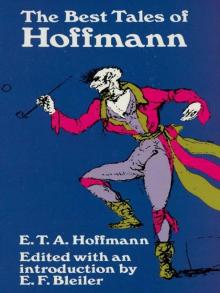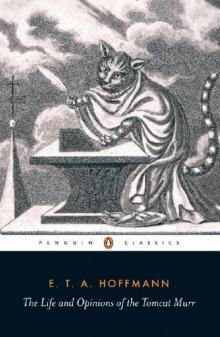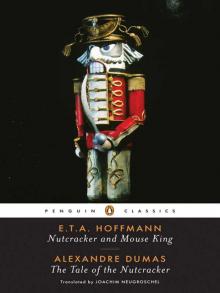- Home
- E. T. A. Hoffmann
The Life and Opinions of the Tomcat Murr Page 2
The Life and Opinions of the Tomcat Murr Read online
Page 2
II
Ernst Theodor Wilhelm Hoffmann was born in the maritime city of Königsberg, capital of the provincial government in East Prussia, on 24 January 1776. In 1804 he adopted the name Amadeus as a sign of his love for Mozart, becoming known as E. T. A. Hoffmann. His childhood was unhappy, not least because he was neglected by his parents, who divorced some years after his birth. His father left Königsberg. His depressive mother returned to her family home, where the boy grew up in the company of his maternal grandmother, his three aunts, and his puritanical and grumpy uncle Otto Wilhelm Doerffer, the ‘O Woe Uncle’ in The Tomcat Murr. In the same house another future writer, Zacharias Werner, was growing up under similarly distressing circumstances with a mother given to frequent bouts of madness. Hoffmann entered school in 1782, meeting Theodor Gottlieb von Hippel, nephew of a well-known author, and the boys became firm friends. From the first, as he wrote in 1818. Hoffmann had an ‘overwhelming interest in music’. There was an active musical life in the city, in which the family fully participated, holding regular musical evenings. Hoffmann was taught the piano by his ‘O Woe Uncle’. He first heard Mozart in these years, encountering The Magic Flute, which shaped his writing, from The Golden Pot to The Tomcat Murr, with its fairy-tale story of initiation and the conflict between the dualities of body and soul, male and female, good and evil. Sarastro and the Queen of the Night live on in Archivarius Lindhorst and the Apple Woman in the Pot, and in Master Abraham and Madame Benzon in The Tomcat Murr. Rousseau’s Confessions inspired him with thoughts of musical composition, and he went on to write over eighty musical works, several of which The Tomcat Murr attributes to Kreisler. However, aged sixteen, Hoffmann entered the University of Königsberg to study law, much against his inclination, though he later enjoyed the subject, and became a distinguished lawyer. Hoffmann’s writings from these years already show the traits that typify his best work. A surviving fragment written around 1796 displays strong traces of Sterne and even whimsically varies the diagrams from Tristram Shandy.4
Hoffmann’s crooked line provides early evidence for his acquaintance with Sterne’s zigzagging narrative technique that later plays such a part in The Tomcat Murr.5
During his probationary period as a lawyer at the court in Königsberg, Hoffmann did not develop his writing but took up painting. He also worked as a piano teacher, falling passionately in love with his pupil, Johanna Dorothea Hatt, a married woman in her late twenties. She returned his affection, and her husband, who was in his sixties, tried to end the affair, which however dragged on by correspondence until 1798. Hoffmann found in her the first embodiment of unattainable feminine perfection he was later to celebrate as Künstlerliebe, the artist’s love which involves rejecting carnality and devoting oneself to an inaccessible ideal. Hoffmann had a similar if deeper experience in Bamberg, where he fell in love with another pupil, the much younger Julia Marc, and Julia’s transfigured image reappears, the object of Künstlerliebe, as Veronica in The Golden Pot and as Julia Benzon in The Tomcat Murr. The affair with Johanna may have driven Hoffmann from home. He had removed from Königsberg to Glogau in 1796, where his uncle Johann Ludwig Doerffer, whom he recalls in The Entail, oversaw his legal work. In Glogau he passed his so-called referendary examinations in 1798, doing ‘exceptionally well’. He followed his uncle’s family to Berlin, experiencing the hustle and bustle which he later celebrated as the first German writer of city life. Around this time he was engaged to his uncle’s daughter, Minna, and through her friendship with the fiancée of the great comic novelist, he met Jean Paul, who subsequently assisted Hoffmann in launching his career.
Having in 1799 passed his finals as an assessor with distinction, he moved the following year to Posen as a Government Assessor, but jeopardized his career by some typical buffoonery. He drew caricatures of several local dignitaries which a friend distributed during the Carnival in February 1802. This cost Hoffmann his job. He was exiled to the dull provincial town of Plock, where he remained from 1802 to 1804, when he was transferred to Warsaw. Before leaving Posen, he dissolved the engagement with Minna, and married the daughter of a Polish court clerk, Michaelina Rorer, with whom he remained until his death. In Posen, too, he witnessed the first public performance of his own work, the Cantata for the Celebration of the new Century. Indeed, as late as 1802, he was still torn between music and painting, wondering ‘whether I was born to be a painter or a musician?’, but in 1803, his first literary work saw print, The Letter from a Monk to his friend in the City, and his third and major talent unfolded.
Hoffmann’s life took an upturn in Warsaw. According to Julius Hitzig, Hoffmann’s future biographer, it was a bustling, cosmopolitan town, typified by the very exoticism Hoffmann evokes in his tales: Hitzig’s description of the streets swarming with Punch-and-Judy shows, dancing bears, camels and apes reads like a tale by Hoffmann himself. Hitzig certainly seems to capture Hoffmann’s appearance in descriptions like this:
Hoffmann was very short of stature, of yellowish complexion, with dark, almost black hair, growing down low upon his forehead, and he had grey eyes, which had nothing remarkable about them when they were at rest, but which assumed an uncommonly humorous and cunning expression when he blinked them, and his mouth was tightly closed.6
The picture is corroborated by Hoffmann’s self-portraits, especially by his engravings. His agile features reappear as caricatures in the descriptions of Kreisler in The Tomcat Murr. Hitzig now introduced Hoffmann to the work of the earlier Romantics, with whom he was of an age, and he also formed close contact with his childhood acquaintance, Zacharias Werner.
However, politics intervened. When Napoleon marched into Warsaw on 19 December 1806, all Prussian officials who refused him their oath of allegiance, as Hoffmann did, lost their posts. The episode is recalled in The Tomcat Murr when Kreisler loses his job. Hoffmann’s wife returned to her family in Posen with their baby daughter Cecilia, who was born in 1805, but sadly died in 1807, and Hoffmann headed for Berlin. The town was flooded with refugees, however, and his attempts to strike lucky as an artist, caricaturist or composer failed, leaving him to endure severe hardship and, on occasion, hunger.
Protracted negotiations brought him an appointment as theatre director in Bamberg, which he took up in 1808. Initially, he voiced delight at the artist’s life, but looking back, he largely remembered his ‘apprenticeship and martyrdom’. After losing his post, and struggling again, he was re-engaged in 1810 as machinist, scene-painter and composer, inter alia contributing to productions of Calderón, Shakespeare – whose plays, like Mozart’s operas, constitute a permanent frame of reference for his stories – and Kleist’s fairy-tale drama, Das Käthchen von Heilbronn. Hoffmann shared with Kleist a fascination with such apparently occult phenomena as dreams and somnambulism, which the latter depicts in terms that recall the popular Romantic classic, G. H. von Schubert’s Aspects of the Dark Side of the Sciences (1808). This book later inspired Hoffmann, too, providing the plot for his tale, The Mines of Falun.
In Bamberg, Hoffmann encountered modern psychiatry, developing the common concern with psychology evident among contemporaries like Tieck and Kleist, and acquainting himself with theories that ultimately issued in the work of Breuer and Freud, and Viktor von Weizsäcker’s holistic medicine. He befriended Adalbert Friedrich Marcus, director of the Bamberg asylum, and the doctor, Friedrich Speyer; the former enabled him to study his patients, and the two men introduced him to contemporary ideas, such as animal magnetism, which recur in his stories and, not least, in The Tomcat Murr. Marcus was familiar with a broad range of theories, including Brownianism, Mesmerism and Gall’s craniology, as well as with J. C. Reil’s influential speculations, and together with the philosopher Schelling edited the Yearbook of Medicine as a Science (1805–8). The technical acuity with which Hoffmann later describes clinical cases, like the imbecile Prince and the Princess’s catatonic state in Murr, and his many characters with split personalities, has caused him to be credited with the first accura
te depiction of schizophrenia. As Hoffmann observed, he did not wish simply to reproduce existing views, but to explore a ‘hitherto untouched aspect of magnetism’, i.e. to develop his own psychology, as he does in Bettina’s Strange Illness (1816). Despite its bizarre style, which echoes Diderot and Sterne, this story gives a precise case-history, based on a true event in Berlin. It seems that contemporary medicine was unable to solve the problem debated by its three characters – a Doctor, a Kapellmeister and a Travelling Enthusiast – who discuss the fate of the singer Betty Marcuse after she mysteriously lost her voice, with no apparent physical cause. The early Freud would have called this hysteria. Today, it would be classed as a dissociative disorder. The story’s Doctor concludes that the disease is ‘more psychological than physical’, but it is left to the Enthusiast to see that the problem began after Bettina left church in the middle of Haydn’s D minor Mass. Deserting God in this manner produced a psychological trauma requiring treatment. He cures her by recounting a parallel case, enabling Bettina to see herself, as if in a mirror: miraculously, her voice returns. This early psychotherapy depends on confronting the patient with an identical case-history as a means to self-knowledge. Such self-reflection runs like a red thread through Hoffmann’s work. Where self-consciousness fails, psychological breakdown prevails, as in the The Sandman and the tale of Saint Serapion. Where it succeeds, as it does triumphantly in Princess Brambilla, the subject attains higher knowledge. Ironically, even the Tomcat Murr undergoes a similar cure when, suffering from acute rowdyism, he sees himself in a mirror and mends his ways. Hoffmann also brings to insanity a forensic concern with human responsibility, evident for example in Mademoiselle de Scudery, and this line was subsequently pursued by Georg Büchner, an attentive reader of Hoffmann’s work, in his own drama of crime, guilt, madness and the forensic problem of responsibility, Woyzeck (1836-7).
The Bamberg years, and the affair with Julia Marc, subsequently found their way into Hoffmann’s continuation of Cervantes’ story, The Latest Experiences of the Dog Berganza. These were the years when Hoffmann’s literary career began to flourish with the articles on Beethoven for the Allgemeine Musikalische Zeitung, which earned him Beethoven’s respect and established him as a major critic, and the publication of his first mature story, Ritter Gluck, in 1809. This tale, which revolves around the composer Gluck, already displays Hoffmann’s inimicable style: it is told by a convivial narrator speaking with the urbane realism through which uncanny events unfold, revealing beyond the everyday both mental instability and a colourful myth of the ‘higher world’. Hoffmann’s work cannot be fully grasped without reference to music, partly because of the role music plays in his writings, not least The Tomcat Murr; but mainly because his early advocacy of a non-representational, imaginary realm depicted in words derives from his notion of music as an autonomous spiritual world.
Hoffmann’s reviews, and especially the Beethoven essays, are a milestone in modern music-writing, providing a model for later musical writers from Schumann to Wagner, and their lessons also feed into the musical ideas of The Tomcat Murr. In the Romantic age, for which criticism belonged to creative writing, Hoffmann’s music essays set a new standard, comparable to that marked by Friedrich Schlegel and Coleridge on literature or Baudelaire on painting. In his day, Hoffmann’s championing of Bach and Gluck was perhaps more remarkable than his Mozart worship, but historically, recognizing Beethoven’s genius was perhaps his chief gift to public taste. As to aesthetics, Hoffmann contributed to a decisive turn. His theory continues the shift from an aesthetic based on ‘imitation’ according to which vocal music deserves pride of place, to a non-representational ideal, developed in early Romanticism, for which instrumental music represents the highest variety, being as Tieck said ‘independent and free’. Affirming music’s priority in Romantic aesthetics, the reviews contribute to the wider turn from painting and the ut pictura poesis doctrine towards music as the paradigm for all art. In his keynote reviews later united as ‘On Beethoven’s instrumental Music’, Hoffmann calls music ‘the most Romantic of all the arts’, and even ‘perhaps the only Romantic art’. By emphasizing music’s priority, he expresses the credo later developed by Schopenhauer in The World as Will and Idea (1819), for whom music represents ‘an objectification and reflection of the entire will as is the world itself’, possessing ‘the same objectivity as that possessed by ideas’. For Schopenhauer as for Hoffmann, then, music assumes a metaphysical role, mediating the absolute. This turn from painting to music was subsequently emphasized in Symbolism, as in Verlaine’s ‘Art poétique’, which pointedly rejects Horace’s ars poetica with its ut pictura poesis doctrine in the opening words, ‘De la musique avant toute chose…’7 As will be seen, Hoffmann provided a vital input to French nineteenth-century aesthetics, which proved another major route by which his ideas impacted on modernity.
In April 1813, having signed the contract for his first collection of tales, Fantasy Pieces in Callot’s Manner, Hoffmann, aged thirty-seven and still more musician than writer, left Glogau for Dresden and Leipzig, in which two cities he was engaged as a music director in Joseph Seconda’s theatre. The two years in Dresden and Leipzig inaugurated his major phase. The lively German towns, his musical activity and the sweeping political changes in those years may have combined to inspire him as a writer, too. He now wrote the major works included in the Fantasy Pieces: the Kreisleriana fragments, which revolve around the same Kapellmeister Kreisler later depicted in The Tomcat Murr, and his first great fairy-tale, The Golden Pot. In narrative terms, it is the Pot which is Hoffmann’s chief work of these years. The Pot bristles with scintillating imagery and ideas. In a dazzling display of narrative skill, Hoffmann invents a new style of fairy-tale, ‘set fair and square in ordinary life’, which amusingly relates the initiation of the student Anselmus into a ‘higher world’, a lyrical Atlantis which brings him into direct contact with a realm comprising both noble ideals and life’s primordial origins, embodied in the little green snake, Veronica. Irony and humour lend the tale’s more serious ideas – on life, love, virtue, society and art-as-religion – a joyous insubstantiality which, in character, can only be compared to music. The operatic freedom Hoffmann brought to literature may have been stimulated by his work during these years, when he conducted Don Giovanni and The Magic Flute as well as operas by Gluck, Cherubini and Weber. A sense of the operatic imbues all Hoffmann’s writing with an awareness of its own fictionality. Yet this should not be misunderstood as escapist. Anyone who doubts Hoffmann’s political awareness could do worse than read his pamphlet of 1814, ‘Vision of the Battlefield near Dresden’, in which he records the slaughter of Napoleon’s army that he witnessed on the journey to Dresden, which several times almost cost him his life. Something of this horror lives on in Hoffmann’s first novel, begun immediately after the Golden Pot, namely The Devil’s Elixir, which is an intricately plotted gothic fiction indebted to Matthew Lewis’s The Monk (1796). The monastic setting recurs, albeit with a more minor role, in The Tomcat Murr, and Murr also shares with the earlier work the use of spine-chilling techniques borrowed from popular literature.
The close links Hoffmann forges between opera and fiction will also have been enhanced by his experience as the composer of six operas. In the Leipzig–Dresden years he wrote his wonderfully rich and evocative Undine, the first Romantic opera. Among its innovations – taken up by Weber and Wagner – is his use of recurring themes or leit-motivs to identify characters, comparable perhaps to the formulaic expressions in his fiction. An operatic synthesis of artistic vision with musical evocativeness permeates his writing. Through such musical evocation, he rehearses his idea, indebted to the Romantic physicist J. W. Ritter, that music constitutes a universal language, a language articulated equally in Kreisler’s sublime choral works, which the reader never hears, and in Murr’s caterwauling.
After the first two volumes of Hoffmann’s Fantasy Pieces had appeared in early 1814, with a Preface by Jean Paul, and following a disagr
eement with Seconda, Hoffmann returned to Berlin, where he took up a position in the Supreme Court or Kammergericht. He was fêted on arrival in the city at a dinner organized by Hitzig, which was attended by the cream of the Berlin Romantics, including Chamisso, Tieck and Fouqué. He subsequently met Eichendorff and Brentano, too. His literary vocation was now clear and his writing entered its final, most productive phase. He published his second collection of stories, the Night Pieces, in 1818, and The Serapiontic Brotherhood followed in four volumes in 1819–21, in which the framework narrative, a dialogue between several friends, elaborates the aesthetic of the serapiontic principle. The title celebrates Hoffmann’s own ‘Serapiontic’ friends, including Hitzig, Salice Contessa and Chamisso, with whom he spent his evenings. Avoiding the salons which had welcomed him on his arrival in Berlin, he preferred conviviality, drinking regularly at celebrated venues such as Lutter & Wegner. There is a particularly delightful portrait of him showing him glass in hand at this pub in the company of his bosom pal, the actor Ludwig Devrient. Something of the wit honed at Lutter & Wegner informs the narrative voice in the later tales and, not least, that of Kreisler’s biographer in The Tomcat Murr, a voice remarkable for its satire and demotic pungency. The novel also reflects his contemporaneous theory in the much-debated serapiontic principle. This develops Hoffmann’s aesthetics in dialogic form, expanding his long-standing ideas. In the Fantasy Pieces, he took his cue from the grotesque artistry of the French engraver, Jacques Callot, and this pictorial inspiration survives in the serapiontic insistence on visualization. The principle involves other key ideas. Above all, it recommends ‘inner vision’, as does the Abbot in The Tomcat Murr during his speech on modern painting. This entails ‘pictorial vividness’ and ‘sculptural plasticity’. The fantastic requires a realistic context, a point also made by the Abbot. Similarly, visionary inspiration requires rational control, too, and it is this ‘reflectivity’ which reveals life’s ‘duality’. Related to this is the emphasis on ‘balance’ and a clear ‘goal’. Like the earlier Romantics, then, Hoffmann elaborates an aesthetics of mixture. This, as Gerhard Kaiser points out, culminates in the idea of ‘kaleidoscopic’ form.8 Referring to Brewster’s recent invention of 1817, the serapiontic discussion opposes the idea of classical organic form by that of kaleidoscopically arranged ‘heterogeneous elements’ which resolve themselves into ‘attractive figures’. This montage theory, which develops Novalis’s idea of the ‘figure’ as an organizational principle, is reflected in The Tomcat Murr, arguably Hoffmann’s most kaleidoscopic work. However, despite its wide reference, the serapiontic principle does not exhaust Hoffmann’s aesthetics. Callot, for example, still remained a touchstone in the Berlin period, providing the inspiration for the bizarre capriccio, The Princess Brambilla. Jokingly adopting the Fichtean terminology of ‘I’ and ‘Not-I’, also used in The Tomcat Murr, the capriccio – it is impossible to ascribe the work to any pre-existing genre – rehearses Hoffmann’s comic ideal. A confused ‘I’, lost in a sublunary carnival world, discovers its higher self in the ‘Not-I’ through humorous self-cognition. Thus the capriccio rehearses the ideal of ‘humour’, rated higher than ‘irony’, which suffuses Hoffmann’s late work. The capriccio divided, and still divides, the critics. Even supporters, like Jean Paul and Hitzig, found its arabesques excessive. On the other hand, Heine and Baudelaire particularly admired it, the latter, in his essay ‘On Laughter’, praising its ‘absolute humour’ and provocatively calling it a ‘catecheism of higher aesthetics’.

_preview.jpg) Weird Tales. Vol. I (of 2)
Weird Tales. Vol. I (of 2)_preview.jpg) Weird Tales, Vol. II (of 2)
Weird Tales, Vol. II (of 2) The Best Tales of Hoffmann
The Best Tales of Hoffmann The Life and Opinions of the Tomcat Murr
The Life and Opinions of the Tomcat Murr Nutcracker and Mouse King and The Tale of the Nutcracker
Nutcracker and Mouse King and The Tale of the Nutcracker The Sandman
The Sandman